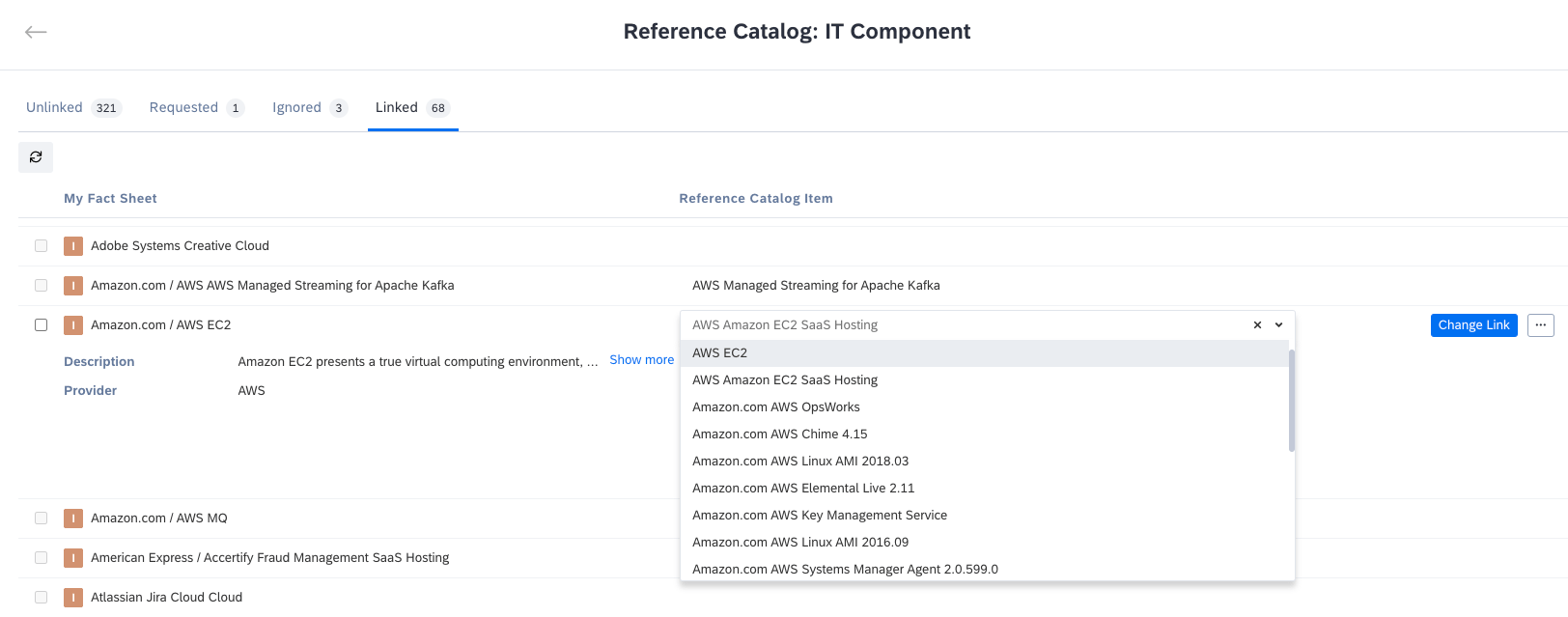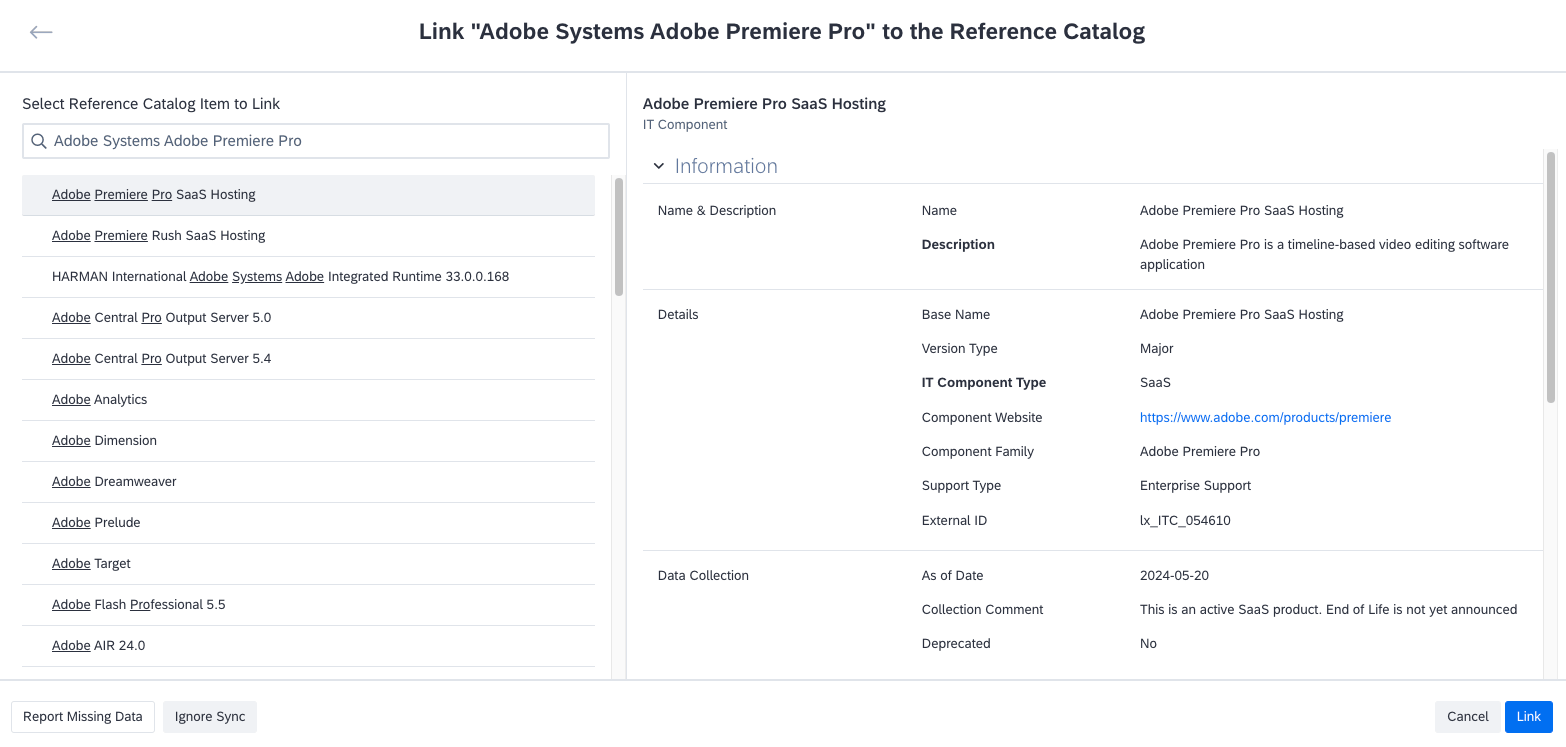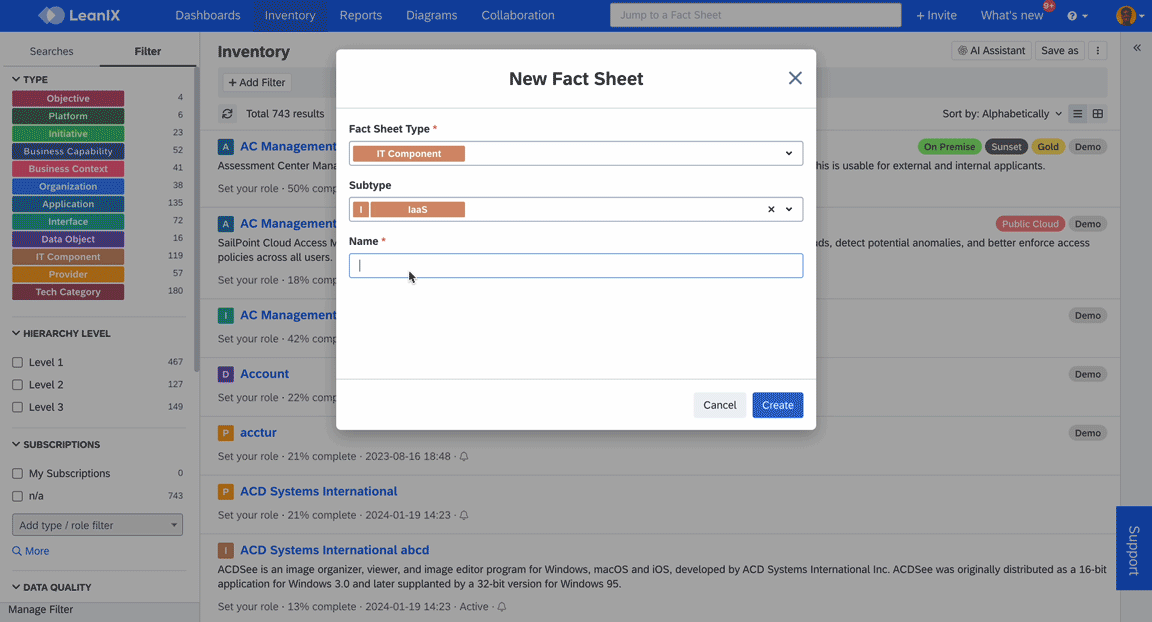IT Components in the Reference Catalog
By using reference data for IT component fact sheets, you can increase standardization and data quality, set relations to other fact sheets for best-practice modeling, as well as manage technology obsolescence risks by using vendor lifecycle information.
Overview
The reference catalog offers standardized data for IT component fact sheets, simplifying the procedure of documenting IT components within SAP LeanIX. To learn more about which IT components are included in the catalog, see Scope of IT Components in the Reference Catalog.
Note
Lifecycle information for IT components is only available as part of the SAP LeanIX Technology Risk and Compliance product. To learn more, see SAP LeanIX Technology Risk and Compliance.
Benefits
By using catalog data for IT component fact sheets, you can:
- Enhance fact sheet standardization: With catalog data, you can establish better naming standardization across fact sheets and avoid duplication if you used multiple methods to populate your inventory.
- Increase fact sheet quality: With catalog data, you can enrich required fact sheet fields, helping users to complete fact sheet information with less effort.
- Maintain up-to-date data: Once IT component fact sheets are linked to the catalog, the information from the catalog is automatically synced and updated whenever there is a change in the catalog's data. You can select which attributes you want to sync with the catalog.
- Get data related to technology risks: The catalog offers vendor lifecycle information, enabling you to manage technology obsolescence risks.
- Set relations for best-practice fact sheet modeling: Linking an IT component to a catalog item can automatically establish relations between fact sheets where the relation is explicit. For relations to be set properly, some fact sheets should already exist in the inventory. If they don’t, the catalog creates related fact sheets. This enables you to get the most out of catalog data without impacting the fundamental model.
Scope of IT Components in the Reference Catalog
In this section, you can find an overview of the catalog’s scope for IT component items.
Note
SAP LeanIX reserves the right to change the scope of the catalog at any given time.
IT Components in Scope
The following fact sheet subtype categories, serving as the interface between applications and providers, fall within the scope of catalog items defined as IT components:
- Software: Major and minor versions of commercial and open-source software products relevant to enterprise architecture and technology risk management with significant lifecycles (for example, Oracle Database, Microsoft Window Server, Red Hat Enterprise Linux, PostgreSQL). In addition, technology product lines or tech stacks without specific versioning and lifecycle information are also included (for example, Angular).
- PaaS: Platform as a Service (PaaS) offering deployment environments in the cloud (for example, Google App Engine, Heroku, Salesforce).
- IaaS: Infrastructure as a Service (IaaS) cloud computing service (for example, Amazon Web Services (AWS) EC2, Microsoft Azure Virtual Machines).
- SaaS: Software as a Service (SaaS) is in most cases an application. It will be accepted if it represents the hosting or if the SaaS application can be used as a component of a larger application (for example, Adobe Systems Adobe Admin Console, SAP LeanIX Enterprise Architecture Management SaaS Hosting).
- Hardware components
IT Components Out of Scope
The following items are not included in the reference catalog:
- Minor, patch, and build versions, as well as editions of commercial and open-source software products that do not provide individual end-of-life information. These are represented in the relevant Major.x or Major.minor.x versions of the same product.
- Client software that has an auto-upgrade feature or is typically managed by a Mobile Device Management (MDM) solution
- Mobile applications and websites that primarily focus on B2C or that are solely used to provide information without functionality that allows them to be embedded in other applications (for example, Amazon, eBay, Facebook)
- Software libraries
- APIs (that are not offered standalone)
- Plug-ins and add-ons for platforms, except for major plug-ins and add-ons of top vendors
- Command-line utilities (for example, grep, awk, sed)
- Hardware drivers and firmware
Fact Sheet Attributes
The table below lists the fact sheet attributes for IT components provided by the reference catalog.
| Fact Sheet Type | Base Attributes | Additional Attributes Available with the SAP LeanIX Technology Risk and Compliance Product |
|---|---|---|
| IT component | - Name and Description - IT Component Subtype - Release - Component Website - Relations to other catalog items - As of Date - External ID | Lifecycle information (phases, URLs, support policies, and more) |
Lifecycle States of IT Components
The lifecycle states provided by the catalog refer to provider dates. The following states are possible:
- Plan: The IT component has been announced by the provider.
- Phase in: The IT component is in beta or early access.
- Active: The IT component is generally available.
- Phase out:
- The product version is no longer actively supported. It may receive passive support or only security updates, or the version is in the sunset phase.
- The date the provider announces that a version will become outdated.
- The product version is not supported for new customers.
- End of life: The component has reached the end of its life cycle and is no longer supported by the provider.
Configuring Settings for Syncing Fields and Establishing Relations
As an admin, you can configure how to use catalog data for IT component fact sheets. Before you start, set up your workspace by clicking Provision Workspace. This action extends the configuration, providing additional features like improved filtering capabilities in the inventory. It also adds a meta model extension that introduces a new field for the reference catalog status.
To configure catalog settings for IT components, follow these steps:
- In the administration area, navigate to the Reference Catalog section, then go to the IT Component tab.
- Select the data fields that you want to sync from the catalog.
- Choose whether to include Provider and Tech Category relations in IT Component fact sheets by selecting the appropriate checkboxes.
- Click Save.
Resyncing IT Components
To update IT components with the latest information from the reference catalog, you can manually resync them by clicking Resync IT Components. This updates all IT components linked to the catalog with the fields and relations defined in your synchronization configuration. A manual resync may be necessary in the following situations:
- As an admin user, you've changed your synchronization configuration settings to include more attributes. Resyncing lets you import selected attributes to fact sheets, regardless of whether these attributes were filled out manually.
- Users accidentally changed some fields related to the catalog on fact sheets, and you want to revert the changes to the standard setup.
When resyncing IT components, proceed with caution, as this action cannot be undone. Before running a manual resync, you can create a snapshot of your workspace in the Export section of the admin area. For more details, see Export.
Linking IT Components to Catalog Items
Note
Both admins and members can manage how fact sheets are linked to catalog items, which includes establishing links, ignoring fact sheets, and modifying existing links. Viewers don't have access to the reference catalog.
When a fact sheet is linked to a catalog item, the attributes selected by the admin are automatically synced with the catalog and regularly updated.
There are three ways to link fact sheets to the catalog:
- Bulk linking fact sheets from the inventory
- Linking individual fact sheets from the fact sheet page
- Linking a fact sheet during fact sheet creation
On the Last Update tab of the fact sheet, you can check any updates made to the linked fact sheet as a result of syncing. Updates done are attributed to the System user ‘reference data’ user.
Bulk Linking IT Component Fact Sheets From the Inventory
To manage linking to catalog items for multiple fact sheets, navigate to the reference catalog page from the inventory. This allows you to preview recommendations for multiple fact sheets, establish links, ignore certain items, and modify existing linked items, all in one location.
To link multiple fact sheets at once, do the following:
- In the inventory, apply filters to refine the list of fact sheets as per your needs.
- On the right-side pane, click IT Component Linking under Reference Catalog. On the catalog page that appears, fact sheets are arranged into different tabs based on whether they're unlinked, ignored, or linked.
- On the Unlinked tab, select a fact sheet, select a relevant catalog item to link to, then click Link.
You can bulk link fact sheets for which recommended items are provided. To do that, select fact sheets, then click Link Selected.

Linking Fact Sheets to Catalog Items in Bulk
Note
The displayed list of IT components is based on the filters you applied in the inventory.
The Confidence column on the right provides an intelligent recommendation indicating the match level between the fact sheet and the catalog item. If you want to focus on fact sheets with very high or high confidence levels, you can use the Filter by confidence option located in the upper-left corner.
The confidence level score is calculated based on the matches between the fact sheet display name and the catalog item name. The confidence levels are categorized as follows:
- Very high (100)
- High (96–99)
- Other, displayed without a text label (below 96)
By expanding each row, you can view a summary of the fact sheet and details of the corresponding catalog item recommendation. If the recommendation doesn't align with your needs, use the search field to find a specific item to link to. You can link, preview, or ignore individual fact sheets in each row. You can also report missing data so the research team at SAP LeanIX can enrich it.
Ignoring IT Component Fact Sheets
You can ignore a fact sheet if you don't want to link it to any catalog item. The fact sheet is moved to the Ignored tab. If needed, you can link ignored fact sheets to catalog items later.
Reasons to ignore include:
- It is a proprietary product, and you do not expect the catalog to have information about it.
- You want to overwrite the information in the linked fact sheet. Ignoring a linked fact sheet effectively unlinks the fact sheet and stops updates from the catalog.
If you used a filter in the inventory, you can ignore multiple fact sheets in bulk on the Unlinked tab. To do that, select fact sheets, then click Ignore Selected. When the Filter by confidence filter is applied, the option to bulk ignore fact sheets is not available.
Note
Ignoring a linked fact sheet halts updates from the catalog.
Changing the Link to a Different Item
You can link a fact sheet to a different catalog item if there is a more appropriate one or if it was inadvertently linked to the current item. Follow these steps:
- On the reference catalog page, navigate to the Linked tab.
- Select a fact sheet, click on the search field to see alternate recommendations or to search for a specific item to change to.
- Choose the appropriate recommendation you want to change to, and click Change Link.

Changing the Link to a Different Item
Report Missing Data in Catalog Items
You can request missing information or request to add a missing catalog item that you need for any IT Component. The research team at SAP LeanIX processes these requests and updates the necessary information. When a missing catalog item is requested, the IT component for which the request was raised is automatically linked once the catalog item is created.
To report missing data or request a missing catalog item, do the following:
- Select Report Missing Data from the menu in the top right corner of the relevant row. It opens an outlay for you to fill.
- Fill in the needed information in the resulting outlay. Add your request in the Request Comments section.
- Click Submit Request.
View your raised requests in the Requested tab of the catalog linking page. Details of the requests, along with their current status, can be viewed here.
The statuses include:
- Open: The request is received and is being processed.
- Input Needed: More input is needed to process the request. In such cases, update the request with needed information by responding to the Collection Comment in the Request Description text box
- Declined: The request raised will not be added to the Catalog. The reasons are mentioned in the Collection Comment.
- Not Created: An error occurred during the creation of the request. Recreate the request with the necessary information.
From the menu on the right, you have the option to update your requests on your own to provide any additional information needed. Declined Requests can be marked as Ignored, allowing you to link them to a different catalog Item.
Linking an IT Component Fact Sheet from the Fact Sheet Page
Follow these steps:
- Open an IT component fact sheet.
- On the right-side panel, under Reference Catalog, click Link Now. The catalog page opens with relevant recommendations for that fact sheet.
- Choose the catalog item to link or search for a specific item to link from the search bar, then click Link.

Linking a Fact Sheet to a Catalog Item from the Fact Sheet Page
Linking an IT Component Fact Sheet During Fact Sheet Creation
You can link an IT component to a catalog item from the fact sheet creation overlay. Follow these steps:
- Enter the name of the IT component in the fact sheet creation overlay. As you type the name, recommendations from the reference catalog appear below the input field.
- Choose the appropriate catalog item, then click Create & Link.

Linking IT Component Fact Sheet During Fact Sheet Creation
Linking Multiple IT Components to the Same Catalog Item
When configuring catalog settings, selecting the Name and Release field for syncing prevents linking multiple fact sheets to the same catalog item. This helps avoid duplicates and name conflicts in workspaces.
However, there are scenarios where linking multiple IT Component fact sheets to the same Catalog entry is needed. To address this, you can exclude the synchronization of the Name and Release field in the catalog settings. This allows you to link multiple fact sheets to the same catalog item.
If you prefer to synchronize the Name and Release field and still want to link multiple fact sheets, a workaround involves creating an abstract parent fact sheet and linking it to the Catalog. Then, model all instances of the same IT Component as child fact sheets under this parent instance.
Implications of Meta Model v4 on IT Components in the Catalog
Items in the catalog have been updated to reflect the new subtypes (SaaS, PaaS, IaaS) introduced with meta model v4. As a result, many of the catalog items previously categorized as 'Software,' 'Hardware,' or 'Service' now fall under one of the three 'as a service' types.
Your existing or new fact sheets linked to catalog items will maintain their current subtype classification until the subtypes SaaS, PaaS, and IaaS are introduced in your workspace. Once introduced, the relevant fact sheets will automatically transition into the new subtypes whenever a catalog item is refreshed with updates.
To update all fact sheets at once after aligning your workspace with Meta Mode v4, you can raise a support ticket at SAP LeanIX Support.
Updated about 2 months ago
